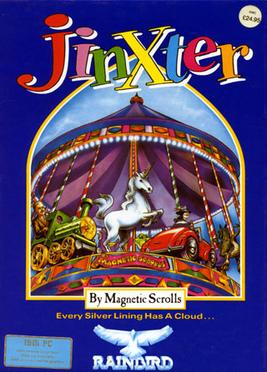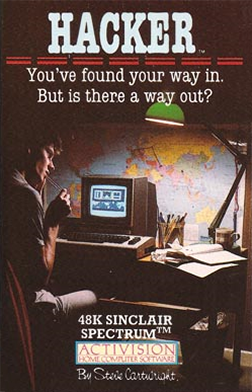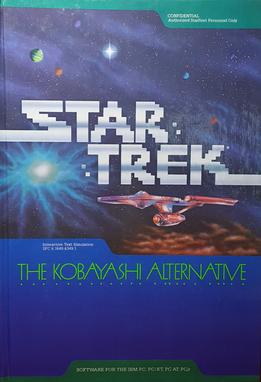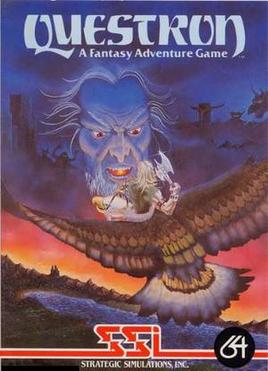Infocom was an American software company based in Cambridge, Massachusetts, that produced numerous works of interactive fiction. They also produced a business application, a relational database called Cornerstone.
Interactive fiction (IF) is software simulating environments in which players use text commands to control characters and influence the environment. Works in this form can be understood as literary narratives, either in the form of Interactive narratives or Interactive narrations. These works can also be understood as a form of video game, either in the form of an adventure game or role-playing game. In common usage, the term refers to text adventures, a type of adventure game where the entire interface can be "text-only", however, graphical text adventure games, where the text is accompanied by graphics still fall under the text adventure category if the main way to interact with the game is by typing text. Some users of the term distinguish between interactive fiction, known as "Puzzle-free", that focuses on narrative, and "text adventures" that focus on puzzles.

Zork is a text adventure game first released in 1977 by developers Tim Anderson, Marc Blank, Bruce Daniels, and Dave Lebling for the PDP-10 mainframe computer. The original developers and others, as the company Infocom, expanded and split the game into three titles—Zork I: The Great Underground Empire, Zork II: The Wizard of Frobozz, and Zork III: The Dungeon Master—which were released commercially for a range of personal computers beginning in 1980. In Zork, the player explores the abandoned Great Underground Empire in search of treasure. The player moves between the game's hundreds of locations and interacts with objects by typing commands in natural language that the game interprets. The program acts as a narrator, describing the player's location and the results of the player's commands. It has been described as the most famous piece of interactive fiction.

Suspended: A Cryogenic Nightmare is an interactive fiction video game written by Michael Berlyn and published by Infocom in 1983. Infocom's sixth game, it was released for Amstrad CPC, Apple II, Atari 8-bit computers, Commodore 64, Commodore Plus/4, IBM PC compatibles, TRS-80, and TI-99/4A. It was later available for Mac, Amiga, and Atari ST.
Questprobe is a trilogy of graphic adventure video games featuring Marvel Comics characters. The three games are Questprobe featuring The Hulk, Questprobe featuring Spider-Man and Questprobe featuring Human Torch and Thing.

Arthur: The Quest for Excalibur is an illustrated interactive fiction video game written by Bob Bates and published by Infocom in 1989. It was released for the Apple II, Amiga, Mac, and IBM PC compatibles. Atypically for an Infocom product, it shows illustrations of locations, characters and objects within the game. It is Infocom's thirty-fourth game and is the second of two Infocom games developed by Challenge using Infocom's development tools.

Spellbreaker is an interactive fiction video game written by Dave Lebling and published by Infocom in 1985, the third and final game in the "Enchanter Trilogy." It was released for the Amiga, Amstrad CPC, Apple II, Atari 8-bit computers, Atari ST, Commodore 64, Classic Mac OS, and MS-DOS. Infocom's nineteenth game, Spellbreaker is rated "Expert" difficulty.

Jinxter is an interactive fiction video game developed by Magnetic Scrolls and published by Rainbird in 1987 for 8-bit and 16-bit home computers of the time. Jinxter tells the story of a man on a mission to save the fictional land of Aquitania from the looming threat of evil witches. The game was well received by critics upon its release.

The Pawn is an interactive fiction game for the Sinclair QL written by Rob Steggles of Magnetic Scrolls and published by Sinclair Research in 1985. In 1986, graphics were added and the game was released for additional home computers by Rainbird.

Archon II: Adept is a strategy/action video game developed by Free Fall Associates: Jon Freeman, Paul Reiche III, and Anne Westfall. It was published in 1984 by Electronic Arts for the Atari 8-bit computers and Commodore 64. Ports followed for the Apple II, Amstrad CPC,ZX Spectrum, and Amiga.

The Hobbit is an illustrated interactive fiction video game released in December 1982 for the ZX Spectrum home computer. Based on the 1937 book The Hobbit, by J. R. R. Tolkien, it was developed at Beam Software by Philip Mitchell and Veronika Megler and published by Melbourne House. It was converted the Commodore 64, BBC Micro, Oric, and other home computers. By arrangement with the book publishers, a copy of the book was included with each game sold.

The Worm in Paradise is the third and final video game in the Silicon Dreams trilogy, a series of text adventure games in which the player takes the role of Kim Kimberly. It is the sequel to Snowball and Return to Eden. Worm in Paradise takes place generations after the first two games, when the planet Eden has been colonised. The player is an ordinary citizen in Eden's most populous city, Enoch. The game was noteworthy for having significant social commentary relative to other games of the same genre and era. The game drew inspiration from the novel 1984.

Hacker is a 1985 video game by Activision. It was designed by Steve Cartwright and released for the Amiga, Amstrad CPC, Apple II, Atari 8-bit computers, Atari ST, Commodore 64, Macintosh, MS-DOS, MSX2, and ZX Spectrum.

Star Trek: The Kobayashi Alternative was a Star Trek themed computer software game by American studio Micromosaics, designed for the Apple II Plus, Apple IIe, and Apple IIc. The game was also available for the Commodore 64, Macintosh and IBM PC. This text adventure was first published in 1985 by Simon & Schuster. The player assumes the role of Admiral James T. Kirk. As Kirk, the player commands the actions of the Enterprise crew, as well as the Enterprise itself.

Questprobe featuring The Hulk is a 1984 graphic adventure video game developed and published by Adventure International in collaboration with Marvel Comics. It is the first entry in Questprobe, an intended series of graphic adventure games that only released three installments before the developer's bankruptcy. The game's narrative follows the Marvel superhero Hulk and his human alter-ego Bruce Banner, who must explore the mysterious lair of the Chief Examiner. The graphics and story outline were created by Marvel artists and writers. Critical reception was generally positive, with much of the praise going to the visuals. Reactions to the gameplay were mixed, especially upon the game's budget re-release, by which time it was considered dated.

Tangled Tales: The Misadventures of a Wizard's Apprentice is a computer game developed by Origin Systems in 1989 for the Apple II, MS-DOS, and Commodore 64.

Amazon is an interactive fiction graphic adventure game. The game was published by Telarium in 1984 and written by Michael Crichton.

Borrowed Time is an interactive fiction game about a detective, who tries to rescue his kidnapped wife. The game was developed by Interplay and published by Activision in 1985. Mastertronic republished it as a budget title as Time to Die.

Lode Runner's Rescue is a 1985 action game developed by Joshua Scholar for the Commodore 64 and Atari 8-bit computers as a follow-up to Doug Smiths's Lode Runner. Lode Runner was published by Broderbund, but the sequel was published under the Synapse Software name, a company acquired by Broderbund in 1984. Lode Runner's Rescue uses isometric projection to give a 3D feel.

Questron is a 1984 game from Strategic Simulations, the first fantasy title from a company known for computer wargames. It was written by Charles Dougherty and Gerald Wieczorek and released for the Apple II, Atari 8-bit computers, and Commodore 64. A sequel, Questron II, was released in 1988.

















